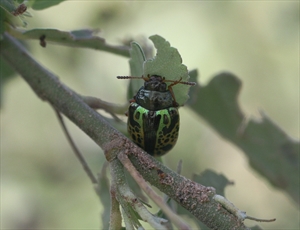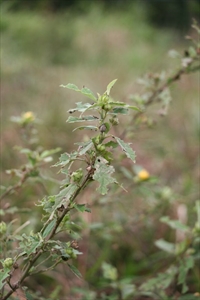Calligrapha beetle
Pacific Pests, Pathogens, Weeds & Pesticides - Online edition
Pacific Pests, Pathogens, Weeds & Pesticides
Calligrapha beetle (352)
Calligrapha pantherina
The beetle is native to Mexico. It was released in the Northern Territory of Australia in 1989, and after its successful control of Sida acuta there, it was later released elsewhere: Papua New Guinea (1999), Fiji (2002) and Vanuatu (2004). In 2016, it had reached New Caledonia without official release, and there was concern it might threaten native Sida species.
Sida acuta (common wireweed), Sida rhombifolia (arrowleaf sida or paddy's lucerne), and Sida spinosa. Sida acuta is native to Central America, and present in South America, Africa, Asia and Oceania. Sida rhombifolia is also common throughout the tropics and sub-tropics. The distribution of these Sida species is very similar in the Pacific islands, but Sida acuta does not occur in Wallis and Futuna according to Waterhouse & Norris1.
Both Sida acuta and Sida rhombifolia are common in pastures, plantation crops, cereals, root crops and vegetables, roadsides and waste lands. They have deep taproots and can withstand drought, mowing and shallow cultivation. Adults (Photos 1-3) and larvae (Photo 4) feed on the leaves and cause severe defoliation of both species (Photos 5&6).
Eggs are laid on the undersides of the older leaves. The larvae stay together after hatching and remain together except for the last moult when they disperse. Pupation takes place in the soil or leaf litter. Adults are brown when first emerged, but then become bright green with black markings.
From egg to adult is about 24 days, with adults living for an average of 18 weeks. The beetle spreads on the wing. If spread needs to be hastened or reintroductions are needed this can be done manually (see Management as Biocontrol Agents).
Reports from Australia record severe defoliation of Sida acuta resulting in vastly reduced seed production and plant density. Over a period of 10 years, there has been considerable impact in northern Australia, especially near coastal wetter sites. There have been reports from landowners that the control of Sida has resulted in a return to native pasture with growth of native herbs and grasses. Equally, there have been promising, though anecdotal accounts, of reductions in stands of Sida rhombifolia in Pacific island countries.
Look for the black larvae that feed together (until the last moult), and adults, iridescent green with black markings, that defoliate Sida plants.
BIOSECURITY CONSIDERATIONS
Tests in Australia found that Sida acuta, Sida rhombifolia and Sida spinosa were good hosts of Calligrapha, and other native plants were relatively poor. However, checks are always needed before the beetle is introduced to any country as part of a biological control program.
FACTORS AFFECTING ESTABLSIHMENT AND SPREAD
Establishment and sustainability of beetle populations in northern Australia depended on the condition of the Sida. During severe dry seasons growth was poor as was the survival of the beetles, and reintroductions were needed.
COLLECTING AND SPREAD
If Calligrapha need to be collected to spread the beetles to new Sida infestations or to reinfest areas where colonisation has failed, then do the following:
- If there are seasons, make collections in the wet, either by hand or by using a butterfly net.
- Collect at least 50 beetles and transfer them to the new site and release them together.
- After 2-3 weeks check for eggs and larvae, and later for adults.
- When the population has established over several square metres collect adults and distribute onto healthy Sida to speed the spread.
AUTHOR Grahame Jackson
1Waterhouse DF, Norris KR (1987) Sida acuta Burman f. Biological Control Pacific Prospects. Inkata Press. Information Julien MH, et al. (Eds.) (2012) Biological control of weeds in Australia. CSIRO Publishing. pp. 525–526. (https://books.google.com.au/books?id=qe9xnWc0oIwC&printsec=frontcover&source=gbs_ge_summary_r&cad=0#v=onepage&q&f=false); and CABI (2017) Sida acuta (sida). Crop Protection Compendium. (https://www.cabi.org/cpc/datasheet/49985); and from Biological control of sida. Department of Land Resource Management. Northern Territory Government. (https://depws.nt.gov.au/__data/assets/pdf_file/0003/258087/Biological-control-of-Sida-2018.pdf). Photo 1 Mani Mua, SPC, Sigatoka Research Station, Fiji; Photos 2,4&5 Celia Symonds, University of NSW, Sydney, Australia.
Produced with support from the Australian Centre for International Agricultural Research under project HORT/2016/185: Responding to emerging pest and disease threats to horticulture in the Pacific islands, implemented by the University of Queensland and the Secretariat of the Pacific Community.









